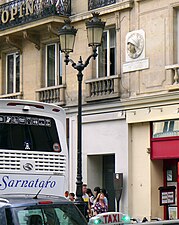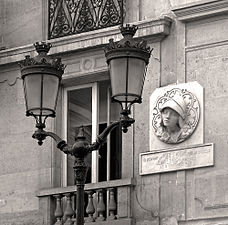Siege of Paris (1429)
This article needs additional citations for verification. (September 2018) |
| Siege of Paris (1429) | |||||||
|---|---|---|---|---|---|---|---|
| Part of the 1415–53 phase) | |||||||
 Joan of Arc at the porte Saint-Honoré during the siege of Paris of 1429 | |||||||
| |||||||
| Belligerents | |||||||
|
|
| ||||||
| Commanders and leaders | |||||||
|
| |||||||
| Strength | |||||||
| 10,000 |
3,000 English citizens of Paris | ||||||
| Casualties and losses | |||||||
|
500 dead 1,000 wounded | |||||||
The siege of Paris was an assault undertaken in September 1429 during the Hundred Years' War by the troops of the recently crowned King Charles VII of France, with the notable presence of Joan of Arc, to take the city held by the English and Burgundians. King Charles's French troops failed to enter Paris, defended by the governor Jean de Villiers de L'Isle-Adam and the provost Simon Morhier, with the support of much of the city's population.
Background
After Henry V of England entered Paris in 1420, the English administration was sympathetic to the citizens of Paris, confirming their former privileges and giving new ones. The Parisians had accepted the English mostly because of their hatred of Charles VII (whom they had nicknamed "King of Bourges") and the Armagnac party, who threatened the many liberties that the city had obtained over the centuries.[1]
After the battle of

In early September, Charles VII established his camp at the butte de Saint-Roch.[4]
On September 3, Joan of Arc accompanied by the Dukes of Alençon and

The Parisians, believing that the Armagnacs wanted to destroy the city from top to bottom, made a vigorous defence.[4] Joan of Arc was given the task of leading the assault to capture the city by Charles VII. Joan of Arc charged towards the main gate with the French army and tried to cross the city's water-filled
Consequences
The city was defended by about 3,000 English commanded by marshal Simon Morhier and governor Jean de Villiers de L'Isle-Adam, which forced Charles VII and his army of 10,000 soldiers to retreat.
Having failed by force, Charles VII, tried to take the city otherwise. In 1430, he staged a plot that was discovered by the English, and led to the
-
Saint-Honoré street at numbers 161-163
-
Commemorative plaque
References
- ^ Larousse, P. (1874). Grand dictionnaire universel du XIXe siècle (in French). Vol. 12. Paris. p. 232.
{{cite book}}: CS1 maint: location missing publisher (link) - ^ Lefèvre-Pontalis 1885, p. 6.
- .
- ^ a b c d Larousse 1874, p. 232.
Further reading
- ISBN 978-2-84050-179-4.)
{{cite book}}: CS1 maint: location missing publisher (link - Grondeux, Anne (1993). "La présence anglaise en France: Les Anglais dans la vallée de la Seine sous la régence du duc de Bedford (1422–1435)" [The English presence in France: The English in the Seine valley under the regency of the Duke of Bedford (1422–1435)]. .
- Thompson, Guy Llewelyn (1991-03-14). Paris and Its People Under English Rule: The Anglo-Burgundian Regime 1420–1436. ISBN 978-0-19-822159-3.


